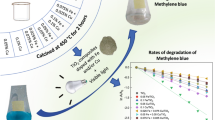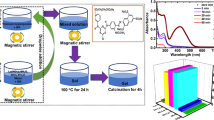Abstract
Nanosized cerium and nitrogen co-doped TiO2 (Ce–TiO2−xNx) was synthesized by sol gel method and characterized by powder X-ray diffraction (PXRD), X-ray photoelectron spectroscopy (XPS), FESEM, Fourier transform infrared, N2 adsorption and desorption methods, photoluminescence and ultraviolet–visible (UV–vis) DRS techniques. PXRD analysis shows the dopant decreases the crystallite sizes and slows the crystallization of the titania matrix. XPS confirm the existence of cerium ion in +3 or +4 state, and nitrogen in −3 state in Ce–TiO2−xNx. The modified surface of TiO2 provides highly active sites for the dyes at the periphery of the Ce–O–Ti interface and also inhibits Ce particles from sintering. UV–visible DRS studies show that the metal–metal charge transfer (MMCT) of Ti/Ce assembly (Ti4+/Ce3+ → Ti3+/Ce4+) is responsible for the visible light photocatalytic activity. Photoluminescence was used to determine the effect of cerium ion on the electron–hole pair separation between the two interfaces Ce–TiO2−xNx and Ce2O3. This separation increases with the increase of cerium and nitrogen ion concentrations of doped samples. The degradation kinetics of methylene blue and methyl violet dyes in the presence of sol gel TiO2, Ce–TiO2−xNx and commercial Degussa P25 was determined. The higher visible light activity of Ce–TiO2−xNx was due to the participation of MMCT and interfacial charge transfer mechanism.







Similar content being viewed by others
References
Gomathi Devi L, Eraiah Rajashekhar K (2011) Mechanochemical reaction of TiO2 with β-alanine for the preparation of visible light active nitrogen doped titania: adsorption and kinetic studies. J Sol–Gel Sci Technol 60(2):144–158. doi:10.1007/s10971-011-2570-0
Asahi R (2001) Visible-light photocatalysis in nitrogen-doped titanium oxides. Science 293(5528):269–271. doi:10.1126/science.1061051
Kobayakawa K, Murakami Y, Sato Y (2005) Visible-light active N-doped TiO2 prepared by heating of titanium hydroxide and urea. J Photochem Photobiol, A 170(2):177–179. doi:10.1016/j.jphotochem.2004.07.010
Enache CS, Schoonman J, Krol RV (2004) The photoresponse of iron- and carbon-doped TiO2 (anatase) photoelectrodes. J Electroceram 13(1–3):177–182. doi:10.1007/s10832-004-5095-x
Lee JY, Park J, Cho JH (2005) Electronic properties of N- and C-doped TiO2. Appl Phys Lett 87(1):011904-1–011904-3. doi:10.1063/1.1991982
Yu JC, Yu J, Ho W, Jiang Z, Jiang L (2002) Effects of F− doping on the photocatalytic activity and microstructures of nanocrystalline TiO2 powders. Chem Mater 14(9):3808–3816. doi:10.1021/cm020027c
Li D, Haneda H, Hishita S, Ohashi N, Labhsetwar NK (2005) Fluorine-doped TiO2 powders prepared by spray pyrolysis and their improved photocatalytic activity for decomposition of gas-phase acetaldehyde. J Fluor Chem 126(1):69–77. doi:10.1016/j.jfluchem.2004.10.044
Liu C, Tang X, Mo C, Qiang Z (2008) Characterization and activity of visible-light-driven TiO2 photocatalyst codoped with nitrogen and cerium. J Solid State Chem 181(4):913–919. doi:10.1016/j.jssc.2008.01.031
Z-h Yuan, J-h Jia, L-d Zhang (2002) Influence of co-doping of Zn(II)+Fe(III) on the photocatalytic activity of TiO2 for phenol degradation. Mater Chem Phys 73(2–3):323–326. doi:10.1016/s0254-0584(01)00373-x
Klosek S, Raftery D (2001) Visible light driven V-doped TiO2 photocatalyst and its photooxidation of ethanol. J Phys Chem B 105(14):2815–2819. doi:10.1021/jp004295e
Liu J, Han R, Zhao Y, Wang H, Lu W, Yu T, Zhang Y (2011) Enhanced photoactivity of V − N codoped TiO2 derived from a two-step hydrothermal procedure for the degradation of PCP—Na under visible light irradiation. J Phys Chem C 115(11):4507–4515. doi:10.1021/jp110814b
Gu D-E, Yang B-C, Hu Y-D (2008) V and N co-doped nanocrystal anatase TiO2 photocatalysts with enhanced photocatalytic activity under visible light irradiation. Catal Commun 9(6):1472–1476. doi:10.1016/j.catcom.2007.12.014
Jaiswal R, Patel N, Kothari DC, Miotello A (2012) Improved visible light photocatalytic activity of TiO2 co-doped with vanadium and nitrogen. Appl Catal B 126:47–54. doi:10.1016/j.apcatb.2012.06.030
Lin W, Frei H (2005) Anchored metal-to-metal charge-transfer chromophores in a mesoporous silicate sieve for visible-light activation of titanium centers. J Phys Chem B 109(11):4929–4935. doi:10.1021/jp040677z
Lin W, Frei H (2005) Photochemical CO2 splitting by metal-to-metal charge-transfer excitation in mesoporous ZrCu(I)-MCM-41 silicate sieve. J Am Chem Soc 127(6):1610–1611. doi:10.1021/ja040162l
Nakamura R, Okamoto A, Osawa H, Irie H, Hashimoto K (2007) Design of all-inorganic molecular-based photocatalysts sensitive to visible light: Ti(IV)–O–Ce(III) bimetallic assemblies on mesoporous silica. J Am Chem Soc 129(31):9596–9597. doi:10.1021/ja073668n
Zhang Y, Yuwono AH, Wang J, Li J (2009) Enhanced photocatalysis by doping cerium into mesoporous titania thin films. J Phys Chem C 113(51):21406–21412. doi:10.1021/jp907901k
Fu C, Li T, Qi J, Pan J, Chen S, Cheng C (2010) Theoretical study on the electronic and optical properties of Ce3+-doped TiO2 photocatalysts. Chem Phys Lett 494(1–3):117–122. doi:10.1016/j.cplett.2010.05.085
Cao XP, Li D, Jing WH, Xing WH, Fan YQ (2012) Synthesis of visible-light responsive C, N and Ce co-doped TiO2 mesoporous membranes via weak alkaline sol–gel process. J Mater Chem 22(30). doi:10.1039/c2jm31576a
Xu J, Ao Y, Fu D (2009) A novel Ce, C-codoped TiO2 nanoparticles and its photocatalytic activity under visible light. Appl Surf Sci 256(3):884–888. doi:10.1016/j.apsusc.2009.08.079
Sontakke S, Modak J, Madras G (2010) Photocatalytic inactivation of Escherischia coli and Pichia pastoris with combustion synthesized titanium dioxide. Chem Eng J 165(1):225–233. doi:10.1016/j.cej.2010.09.021
Zhu X, Shen M, Lobban LL, Mallinson RG (2011) Structural effects of Na promotion for high water gas shift activity on Pt–Na/TiO2. J Catal 278(1):123–132. doi:10.1016/j.jcat.2010.11.023
Xie J, Jiang D, Chen M, Li D, Zhu J, Lü X, Yan C (2010) Preparation and characterization of monodisperse Ce-doped TiO2 microspheres with visible light photocatalytic activity. Colloids Surf A 372(1–3):107–114. doi:10.1016/j.colsurfa.2010.09.037
Yu T, Tan X, Zhao L, Yin Y, Chen P, Wei J (2010) Characterization, activity and kinetics of a visible light driven photocatalyst: cerium and nitrogen co-doped TiO2 nanoparticles. Chem Eng J 157(1):86–92. doi:10.1016/j.cej.2009.10.051
Prasad K, Bally Philippe AR, Schmid E, Levy F, Benoit J, Barthou C, Benalloul P (1997) Ce-doped TiO2 insulator in thin film electroluminescent device. J Appl Phys 36:5696–5702. doi:10.1143/JJAP.36.5696
Yang X, Cao C, Erickson L, Hohn K, Maghirang R, Klabunde K (2009) Photo-catalytic degradation of Rhodamine B on C-, S-, N-, and Fe-doped TiO2 under visible-light irradiation. Appl Catal B 91(3–4):657–662. doi:10.1016/j.apcatb.2009.07.006
Wang Y, Huang Y, Ho W, Zhang L, Zou Z, Lee S (2009) Biomolecule-controlled hydrothermal synthesis of C-N–S-tridoped TiO2 nanocrystalline photocatalysts for NO removal under simulated solar light irradiation. J Hazard Mater 169(1–3):77–87. doi:10.1016/j.jhazmat.2009.03.071
Jagadale TC, Takale SP, Sonawane RS, Joshi HM, Patil SI, Kale BB, Ogale SB (2008) N-doped TiO2 nanoparticle based visible light photocatalyst by modified peroxide sol − gel method. J Phys Chem C 112(37):14595–14602. doi:10.1021/jp803567f
Khalil KMS, Zaki MI (1997) Synthesis of high surface area titania powders via basic hydrolysis of titanium(IV) isopropoxide. Powder Technol 92(3):233–239. doi:10.1016/s0032-5910(97)03250-6
Bensalem A, Bozon-Verduraz F, Delamar M, Bugli G (1995) Preparation and characterization of highly dispersed silica-supported ceria. Appl Catal A 121(1):81–93. doi:10.1016/0926-860x(95)85012-0
Li FB, Li XZ, Hou MF, Cheah KW, Choy WCH (2005) Enhanced photocatalytic activity of Ce3+–TiO2 for 2-mercaptobenzothiazole degradation in aqueous suspension for odour control. Appl Catal A 285(1–2):181–189. doi:10.1016/j.apcata.2005.02.025
Reddy BM, Khan A, Yamada Y, Kobayashi T, Loridant S, Volta J-C (2002) Surface characterization of CeO2/SiO2 and V2O5/CeO2/SiO2 catalysts by Raman, XPS, and other techniques. J Phys Chem B 106(42):10964–10972. doi:10.1021/jp021195v
Reddy BM, Khan A, Yamada Y, Kobayashi T, Loridant S, Volta J-C (2003) Raman and X-ray photoelectron spectroscopy study of CeO2 − ZrO2 and V2O5/CeO2 − ZrO2 catalysts. Langmuir 19(7):3025–3030. doi:10.1021/la0208528
Park PW, Ledford JS (1996) Effect of crystallinity on the photoreduction of cerium oxide: a study of CeO2 and Ce/Al2O3 catalysts. Langmuir 12(7):1794–1799. doi:10.1021/la950002a
Rynkowski J, Farbotko J, Touroude R, Hilaire L (2000) Redox behaviour of ceria–titania mixed oxides. Appl Catal A 203(2):335–348. doi:10.1016/s0926-860x(00)00497-x
Francisco MSP, Mastelaro VR, Nascente PAP, Florentino AO (2001) Activity and Characterization by XPS, HR–TEM, Raman spectroscopy, and BET surface area of CuO/CeO2–TiO2 catalysts. J Phys Chem B 105(43):10515–10522. doi:10.1021/jp0109675
Yang S, Feng Y, Wan J, Zhu W, Jiang Z (2005) Effect of CeO2 addition on the structure and activity of RuO2/γ-Al2O3 catalyst. Appl Surf Sci 246(1–3):222–228. doi:10.1016/j.apsusc.2004.11.013
Wang H, Chen X, Gao S, Wu Z, Liu Y, Weng X (2013) Deactivation mechanism of Ce/TiO2 selective catalytic reduction catalysts by the loading of sodium and calcium salts. Catal Sci Technol 3(3). doi:10.1039/c2cy20568h
Chen X, Burda C (2004) Photoelectron spectroscopic investigation of nitrogen-doped titania nanoparticles. J Phys Chem B 108(40):15446–15449. doi:10.1021/jp0469160
Yu J, Wang G, Cheng B, Zhou M (2007) Effects of hydrothermal temperature and time on the photocatalytic activity and microstructures of bimodal mesoporous TiO2 powders. Appl Catal B 69(3–4):171–180. doi:10.1016/j.apcatb.2006.06.022
Yu J, Yu H, Cheng B, Zhou M, Zhao X (2006) Enhanced photocatalytic activity of TiO2 powder (P25) by hydrothermal treatment. J Mol Catal A: Chem 253(1–2):112–118. doi:10.1016/j.molcata.2006.03.021
Joshi MM, Labhsetwar NK, Mangrulkar PA, Tijare SN, Kamble SP, Rayalu SS (2009) Visible light induced photoreduction of methyl orange by N-doped mesoporous titania. Appl Catal A 357(1):26–33. doi:10.1016/j.apcata.2008.12.030
Xu AW, Gao Y, Liu HQ (2002) The preparation, characterization, and their photocatalytic activities of rare-earth-doped TiO2 nanoparticles. J Catal 207(2):151–157. doi:10.1006/jcat.2002.3539
Nagaveni K, Hegde MS, Madras G (2004) Structure and photocatalytic activity of Ti1− x M x O2±δ (M = W, V, Ce, Zr, Fe, and Cu) synthesized by solution combustion method. J Phys Chem B 108(52):20204–20212. doi:10.1021/jp047917v
Lin H-L, Wu C-Y, Chiang R-K (2010) Facile synthesis of CeO2 nanoplates and nanorods by [100] oriented growth. J Colloid Interface Sci 341(1):12–17. doi:10.1016/j.jcis.2009.04.047
Yang H, Deng Y, Du C (2009) Synthesis and optical properties of mesoporous MCM-41 containing doped TiO2 nanoparticles. Colloids Surf A 339(1–3):111–117. doi:10.1016/j.colsurfa.2009.02.005
Bailes M, Cameron PJ, Lobato K, Peter LM (2005) Determination of the density and energetic distribution of electron traps in dye-sensitized nanocrystalline solar cells. J Phys Chem B 109(32):15429–15435. doi:10.1021/jp050822o
Lin L, Zheng RY, Xie JL, Zhu YX, Xie YC (2007) Synthesis and characterization of phosphor and nitrogen co-doped titania. Appl Catal B 76(1–2):196–202. doi:10.1016/j.apcatb.2007.05.023
Wang J, Zhu W, Zhang Y, Liu S (2007) An efficient two-step technique for nitrogen-doped titanium dioxide synthesizing: visible-light-induced photodecomposition of methylene blue. J Phys Chem C 111(2):1010–1014. doi:10.1021/jp066156o
Trifirò F (1998) The chemistry of oxidation catalysts based on mixed oxides. Catal Today 41(1–3):21–35. doi:10.1016/s0920-5861(98)00035-2
Orera V, Merino R, Pena F (1994) Ce3+↔Ce4+ conversion in ceria-doped zirconia single crystals induced by oxido-reduction treatments. Solid State Ionics 72:224–231. doi:10.1016/0167-2738(94)90151-1
Yen WM, Raukas M, Basun SA, van Schaik W, Happek U (1996) Optical and photoconductive properties of cerium-doped crystalline solids. J Lumin 69(5–6):287–294. doi:10.1016/S0022-2313(96)00107-X
Elidrissi B, Addou M, Regragui M, Monty C, Bougrine A, Kachouane A (2000) Structural and optical properties of CeO2 thin films prepared by spray pyrolysis. Thin Solid Films 379(1–2):23–27. doi:10.1016/s0040-6090(00)01404-8
Coronado JM, Javier Maira A, Martínez-Arias A, Conesa JC, Soria J (2002) EPR study of the radicals formed upon UV irradiation of ceria-based photocatalysts. J Photochem Photobiol, A 150(1–3):213–221. doi:10.1016/s1010-6030(02)00092-8
Reddy BM, Khan A, Yamada Y, Kobayashi T, Loridant S, Volta J-C (2003) Structural characterization of CeO2–TiO2 and V2O5/CeO2–TiO2 catalysts by Raman and XPS techniques. J Phys Chem B 107(22):5162–5167. doi:10.1021/jp0344601
Zheng SY, Andersson-Fäldt AM, Stjerna B, Granqvist CG (1993) Optical properties of sputter-deposited cerium oxyfluoride thin films. Appl Opt 32(31). doi:10.1364/ao.32.006303
Liu H, Li XZ, Leng YJ, Li WZ (2003) An alternative approach to ascertain the rate-determining steps of TiO2 photoelectrocatalytic reaction by electrochemical impedance spectroscopy. J Phys Chem B 107(34):8988–8996. doi:10.1021/jp034113r
Xie Y, Yuan C (2003) Visible-light responsive cerium ion modified titania sol and nanocrystallites for X-3B dye photodegradation. Appl Catal B 46(2):251–259. doi:10.1016/s0926-3373(03)00211-x
Szczepankiewicz SH, Moss JA, Hoffmann MR (2002) Slow surface charge trapping kinetics on irradiated TiO2. J Phys Chem B 106(11):2922–2927. doi:10.1021/jp004244h
Di Camillo D, Ruggieri F, Santucci S, Lozzi L (2012) N-doped TiO2 nanofibers deposited by electrospinning. J Phys Chem C 116(34):18427–18431. doi:10.1021/jp302499n
Emeline AV, Sheremetyeva NV, Khomchenko NV, Ryabchuk VK, Serpone N (2007) Photoinduced formation of defects and nitrogen stabilization of color centers in N-doped titanium dioxide. J Phys Chem C 111(30):11456–11462. doi:10.1021/jp071181v
Acknowledgments
Authors thank to University Grants Commission (UGC), RKE thanks UGC for awarding Dr. D. S. Kothari Post Doctoral Fellowship.
Author information
Authors and Affiliations
Corresponding author
Rights and permissions
About this article
Cite this article
Eraiah, R.K., Madras, G. Metal–metal charge transfer and interfacial charge transfer mechanism for the visible light photocatalytic activity of cerium and nitrogen co-doped TiO2 . J Sol-Gel Sci Technol 71, 193–203 (2014). https://doi.org/10.1007/s10971-014-3350-4
Received:
Accepted:
Published:
Issue Date:
DOI: https://doi.org/10.1007/s10971-014-3350-4




